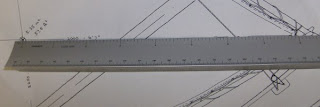I slathered a layer of epoxy on the interior sides of some panels the other night, but the really big news here is that I've begun to make my sail. I got the fabric today from Rockywoods, and by the end of the evening I'd measured and cut out the two halves of the sail.
The fabric (a 4-oz ripstop polyester) is attractive and lightweight. One side is coated with a urethane treatment of some sort, so there's a slight color difference between the sides. But appearance isn't high on my priority list, and anyway, it'll look way better than a blue tarp would have.
 |
| Squeezing 57 sqft of sail into 5 yards of fabric. |
I rolled it out and followed the instructions in the plans for squeezing the entire sail into 5 yards of fabric. (The plans discuss doing this with 6' wide fabric; my fabric was about 5' wide, but it fit. Just barely....)
For a while, I was at a loss as to how to get the shape from the plans to the cloth. The plans list the length of the curved head and foot of the sail, and they list the length of the center of the sail, but there was no list of offsets at various station lines like there had been for the plywood. There was also some confusion as to how I could get the proper curve for the hollow at the open end of the crab claw.
I had learned in my navigation class how to use an engineer's scale to read a measurement from a nautical chart, and I had heard somewhere that you can do the same thing with boat plans. So I got the engineer's rule from my nav gear and confirmed the width of the sail at the top, which allowed me to determine that the sail curves inwards one foot from the tips to the center. Once I've joined the two halves, I'll draw that curve in with a batten.
 |
| If you look closely at the full-sized version of this pic, you can see that the plans read 6'7" (or 79") along this line. The plans are at 1:10 scale, and I've laid the 1:10 edge of my engineer's rule along the line. This allows me the determine that the length shown is indeed 79". It's unnecessary for this sort of situation, but this technique is useful if you want a dimension that's not given in the plans. As long as your rule has a scale that matches the scale of your plans, it will work. |
I decided the best way to get the shape of the long curve onto the cloth would be to carefully mark the three corners, then mark the length of the curved side on a batten, and then use exactly that much batten to draw in the curve. My boys helped again - they're getting to be pro's after the plywood drafting job.
I soon had the shape of the two sail halves drawn in, but it would be a mistake to cut along those lines. The center seam needs some overlap, and it takes fabric to enclose the rope that's supposed to strengthen each edge. So I traced in a second line in a different color, 1.5" from the edge of the sail, and this is the line I cut.
When it was all done, I had two halves of a crabclaw sail. I couldn't resist the temptation to lay them out together to get a sense of the full size of the thing. At 57.5 sqft of sail area, it's a pretty powerful rig. Setting it out in the living room brought that home a bit - it seems bigger than the sail for my El Toro dinghy, which weighs about the same.
Next up in sailmaking: I'll be pinning and stitching the center seam together. I also need to procure some rope for the edges so I can sew those in. I may also cut some reinforcement radius pieces for the corners out of my meager scrap pile. It seems smart - most sails have reinforcement patches there.
Meanwhile, I still have interior epoxy coating to do. Everything is supposed to get two coats, with a bit of sanding between. And if I'm close to having a sail, I really ought to consider getting the spars finished. Plenty to do!







